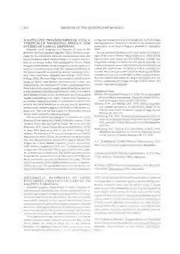
A satellite tracked drifter with a vertically migrating drogue for studies of larval dispersal PDF
Preview A satellite tracked drifter with a vertically migrating drogue for studies of larval dispersal
MEMOIRS OF THE QUEENSLAND MUSEUM A SATELLITE TRACKED DRIFTER WITH A voltage are transmitted 6 to 8 times per day by CLS-Argos VERTICALLY MIGRATING DROGUE FOR tracking telemetry. Sea trials of the device are underway and STUDIES OF LARVAL DISPERSAL deployment in the Gulf of Papua is planned for Decomber Potential larval dispersal is 2 function of time in the 1990). plankton and hydrographic regimes. This is further compli- Future models of the drifier will 8react9 ta the environment cated by the interaction between environmental cucs and and will be able to 8behave9 more realistically, They will be larval responses which dictate changes in vertical disinbu- programmed with luxon specific behaviour régimes and tion of the larvae within that hydrographic milieu. These ontogenetic changes in behaviour will also be possible. An changes in distribution can be onlogenetic, cyclic (diurnal or in site (emperature sensor will monitor the environment and tidal) ora combination of both. The vertical distribution of control the 8growth tate9 of larvae and their allendant be- the larvae is usually measured by discrete sampling over i haviour, An in sit light meter will allaw the drogue to follow very short time frame (Rimmer and Phillips, 1979; Roth- iso]umes and react to variable light intensity and penetration, lisberg, 1982). Because long-term, yertically-stratified sam> An echu sounder will allaw the drogue to migrate near the bottom, permitting movement through shallow water and pling of larvae and known environmental simul are impracticable, the advection of larvae is extrapolated from entrance into nursery grounds. these limited observations using a mean larval behaviour and a fixed circulation (Phillips and Williams, 1986) or estimated Literature Cited from models of both the larval behaviour and hydrographic Phillips, B.F. and McWilliams, P.S. 1986. The pelagic phase regime (Rothlisberg er a@/.. 1983), A more direct approach to of spiny lobster development. Canadian Journal of Fish- estimating dispersal pathways and potential is a device that eries und Aquatic Sciences 43; 2153-2163. mimics the larval behaviour in situ and can be monitored Rimmer, D.W. and Phillips, B.F. 1979. Diurnal migration continuously, remotely and over the length of the planktonic and vertical distribution of phyllosoma larvae of the larval life. This was the motivation for the satellite-tracked western tock lobster Panulirus cygnus George. Marine Biology 54; 109-124, drifter with a vertically migrating drogue, The current drifter was designed to estimate the larval Rothlisberg. P.C. 1982, Vertical migration and its effect on dispersal of penaeid shrimp larvae in the Guolf Cafrpe n- dispersal of the ornate rock lobsier Panalirus ormadus, in the taria, Australia, Fishery Bulletin of the United Status 80: northern Coral Sea and Gulf of Papua, We have used the 541-354, behaviour of P, eygnus larvae (Rimmer and Phillips, 1979) Rothlisberg, P.C., Church, J.A. and Forbes, A.M.G. 1983. as there have been no studies of the larval ecology of P. Modelling the advection of vertically migrating shrimp ornatus. Phyllosomes of P. cygnus undérgo diurmal Vertical larvae. Journal of Marine Research 44; 511-538, migrations. of 100 to 150 m, are planktonic tor periods up to one year and potentially disperse over oceanic basins, The PC. Rothiisbere, CSIRO Marine Laboratortes, P.O. drogue has a fixed diural migration pattern, activated by Bax 120, Cleveland, Queensland 4163, Australia. light intensity, migrating al 10 m min between the surface at night and 130 m by day, The drogue is titted with a sensor so its depth can be monitored. The drifter uses solar power 1. Helmond, CSIRO Marine Laboratories, G.P.O. Rex lo operate the winch and contro! electronics while the tele- 7538, Hobart, Tasmania 7007, Australia metry transmitter uses dry cell batteri¢s for power, The lite span of the drifler, as dictated by baltery capacity. is upproxi~ mately one year. The geographic position of the drifter, the W, Dall, CSIRO Marine Labarateries, P.O. Bax 120, depth of the drogue, sutface temperature, seu state and battery Cleveland, Queensland 4163, Australia. METABOLIC RESPONSES OF SOME 20°C, using Curtesian diver microrespirometers. Larvae of ESTUARINE CRUSTACEAN LARVAE TO Ihe vliwohuline or Freshwater species showed salinity inde- SALINITY VARIATION pendent metabolic rates over the salinity range 7-28 ppt Esluarine systems, characterised by large varjaftions in while larvae of the mesohaline species regulate metabolism environmental parameters, aré widely recounised beth as overa higher salinity range, 14-35 ppt. Larvae of he marine areas Of high productivity aad as rearing grounds fora variety species (cuhaline), however, regulated metabolism over the of marine and treshwarer crustaceans. In arder to hecome salinity range 2)435 pp. Such resulis tncicare Wat We larvae successfully adapted to this special environment, larval of these species, although developing in the same biotope, crustaceans must he able to tolerate such variations, specially respond differently to salinuly Variations, revealing in some in salinity. Although the influence of environmental parame- Terk.on fhe metabolic rare al adulr crustaceans has been the cases, greater metabolic regulation in (he silinity range ape subject of several studies, few papers have dewlt wilh Jarvac. proximating thal of the adult enyjronment, This paper presents data on some crustacean larvae whieh inhabit estuarine waters along the coast of the State of Sap Gloria Sogres Moreinn, Departamento de Fisiologia Geral Inytiiuie de Biocténcias ¢ Instituto de Biologia Pauto, Brazil, the adults of whieh Jive in very different biotopes. The metabolic rates of these larvae Were deter- Marinha, Universidade de San Paulo, San Paulo, mined in different salinities (0.2, 7. 14,21, 28 and 44 pps) ar Frrazil.
